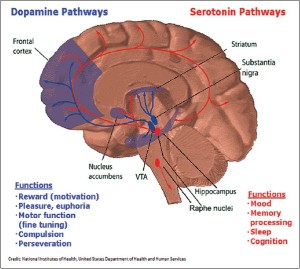Part 1
 Drug addiction is a form of seeking. The high we get from drugs is the closest thing to the altered states of consciousness that are the hallmark of deeper states of meditation, including samadhi, and thus drug users—most unconsciously—are seeking what we all are: the internal source of bliss. Bliss can only be achieved from within, whether it be inspiration, fulfillment, joy or any other state of being; it is an inside job. Drug addiction, then, is like any other attachment to the external world—it is our seeking fulfillment from things outside of us.
Drug addiction is a form of seeking. The high we get from drugs is the closest thing to the altered states of consciousness that are the hallmark of deeper states of meditation, including samadhi, and thus drug users—most unconsciously—are seeking what we all are: the internal source of bliss. Bliss can only be achieved from within, whether it be inspiration, fulfillment, joy or any other state of being; it is an inside job. Drug addiction, then, is like any other attachment to the external world—it is our seeking fulfillment from things outside of us.
The quest for bliss, or a something other than what we experience in the purely physical world, is a real and ubiquitous drive—a universal human yearning. We bounce from experience to experience, desire to desire, and even relationship to relationship—what the yogis would call gaining knowledge—seeking this bliss. And all these quests for the outer are necessary to lead us to the reality of the inner. Drugs and chemical highs are no exception. In fact, former drug users may even be at an advantage on this quest, as the altered states so familiar to substance abusers most closely approximates the different states the meditator passes through on his or her way to Self-realization.
Learning the Self is the most rewarding experience we can have, as it lasts a lifetime. While every former drug user has learned invaluable lessons about herself, only through conscious awareness and awakening can true Knowledge—and all it affords—be had. In seeking the Self the greatest of all fulfillments is ours—the bliss we are never able to find in outer experiences. By taking on this quest, the former drug user has the greatest probability of remaining clean, because what is a temporary high when compared to bliss?
 The quest to “find” the Self can be carried out by a number of paths. One such path is meditation. Meditation, the art of silencing the mind and going within, is a profound practice, one which has a number of short and long term benefits for the former drug user. The benefits range from the physical, like a decreased risk of debilitating cardiac events, to the mental (increased emotional control), to the spiritual, like greater creative inspiration. In the following paragraphs, I will touch upon these benefits of body, mind and spirit to encourage former users to take up the habit of going within. I am certain that when I am finished you will see that the enormous advantages the practice of meditation affords are far greater than any momentary highs we get from drugs.
The quest to “find” the Self can be carried out by a number of paths. One such path is meditation. Meditation, the art of silencing the mind and going within, is a profound practice, one which has a number of short and long term benefits for the former drug user. The benefits range from the physical, like a decreased risk of debilitating cardiac events, to the mental (increased emotional control), to the spiritual, like greater creative inspiration. In the following paragraphs, I will touch upon these benefits of body, mind and spirit to encourage former users to take up the habit of going within. I am certain that when I am finished you will see that the enormous advantages the practice of meditation affords are far greater than any momentary highs we get from drugs.
The Way I Feel
Drugs feel good—we can thank the dopamine system for that. But the physiological sensations resulting from drug actions are temporary and come with the risks of tolerance, withdrawal and potential overdose. Going within, on the other hand, particularly via the path of meditation, provides physiological changes which are longer lasting, and many even permanent. These physical changes can feel good too, but they are subtle and come on gradually, so there is really no high with true meditation.
Meditation has been shown to reduce the risk of cardiac events—like heart attack and stroke—by one half. At risk African American men and women were given either a meditation program, muscle relaxation exercises or conventional health education courses. Those participants who meditated had nearly half the risk of suffering a cardiac event. These findings are particularly valuable for recovering methamphetamine and cocaine users, as stimulants can stress the cardiovascular system (heart and blood vessels). Further, the practice of pranayama (breath control) works to slow the metabolism, bringing down heart rate, respiration and blood pressure. These physiological changes are imperative for any person who has been artificially speeding up their cardiovascular system with drugs.
Meditation also has been shown to reduce pain, fatigue and depression. Many people who suffer from chronic illness turn to drugs to alleviate pain. A 2010 study showed that an eight-week course of mindfulness training reduced all three symptoms above, and improved health-related quality of life for people suffering from multiple sclerosis (MS). As any long-term drug user will tell you: part of the package that comes with substance abuse is pain, fatigue and ultimately depression. Here we now have evidence of the power of going within for alleviating these overloading sensations which often plague chronic drug users.
 Finally meditation may lead to improved healing—something every drug user needs, as repeated use of chemicals can and does lead to breakdown of the body. Both inflammation and immunity are altered by meditation. Inflammatory processes have been observed to diminish, while immune function has been found to increase in regular meditators. As self-healing, self-regulating organisms, we need our innate powers to function unimpeded. While drug use hinders our healing abilities, quieting the mind and going within enhances them instead. Choose meditation and watch your miraculous regenerative powers operate in full force as your body and mind return to their most optimal functioning states.
Finally meditation may lead to improved healing—something every drug user needs, as repeated use of chemicals can and does lead to breakdown of the body. Both inflammation and immunity are altered by meditation. Inflammatory processes have been observed to diminish, while immune function has been found to increase in regular meditators. As self-healing, self-regulating organisms, we need our innate powers to function unimpeded. While drug use hinders our healing abilities, quieting the mind and going within enhances them instead. Choose meditation and watch your miraculous regenerative powers operate in full force as your body and mind return to their most optimal functioning states.













